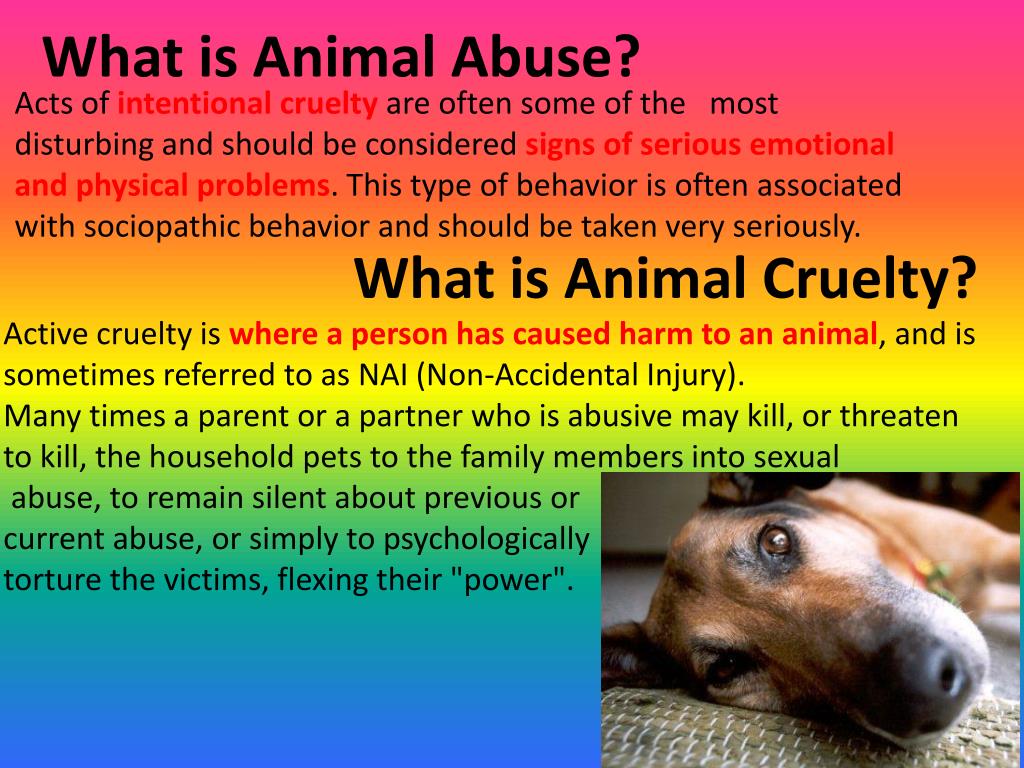Animal cruelty is a pervasive issue that transcends borders and cultures, manifesting in various forms that often evoke horror and disbelief. Yet, what does it truly mean to inflict cruelty upon animals? Is it merely the overt acts of violence and neglect that we readily identify, or does it encompass a broader spectrum of behaviors and systemic problems? This inquiry invites us to critically evaluate our perceptions and responsibilities toward the creatures that share our planet.
At its core, animal cruelty refers to the intentional infliction of harm, suffering, or distress upon animals. The American Society for the Prevention of Cruelty to Animals (ASPCA) defines it as both active and passive cruelty, encompassing both acts of commission—such as physical abuse or abandonment—and acts of omission, like failing to provide adequate care or medical attention. This dichotomy lays the groundwork for understanding how various types of cruelty can manifest.
One primary category of animal cruelty is physical abuse. This form might entail beating, kicking, or otherwise assaulting an animal, resulting in immediate pain and injury. However, the subtlety of neglect often proves to be just as damaging, if not more so in some cases. For instance, consider a dog left in a backyard without shelter, food, or water. Over time, this neglect can lead not only to physical ailments but also to psychological distress, creating long-term trauma for the animal.
Moreover, animal cruelty isn’t confined to domestic contexts. In agriculture, practices like factory farming often institutionalize cruelty on a staggering scale. Animals raised for food products frequently endure horrific conditions characterized by overcrowding, inhumane handling, and a complete disregard for their welfare. This systemic cruelty raises ethical questions about the very nature of food production and our complicity in these practices. Do consumers consider the animals behind their meals when they sit down to eat?
Another, perhaps less apparent form of animal cruelty is executable through entertainment and recreational activities. Instances of exploitation in circuses, zoos, or dog fighting exemplify this issue. Animals are frequently subjected to rigorous training regimens and kept in confined spaces. Moreover, the stimulation of violence for human entertainment highlights a troubling moral quandary. What level of enjoyment warrants the suffering of another sentient being?
Furthermore, animal testing in the name of scientific research poses another significant ethical dilemma. While proponents argue that such procedures contribute to medical advances, the question remains: at what cost? The anguish experienced by countless animals subjected to experimental procedures cannot be overlooked. The quest for knowledge, though noble in intent, confronts the unforgiving reality of suffering inflicted on innocent lives. This leads to a critical challenge: can humanity find alternatives that respect animal rights while still pursuing valuable scientific inquiry?
Moreover, subtle societal notions contribute to the perpetuation of animal cruelty. Cultural attitudes can often justify neglect or abuse, framing it as traditional or acceptable within certain contexts. Additionally, lack of education and awareness about animal welfare compounds the problem. Many individuals may not recognize the signs of cruelty or understand their responsibility in reporting it. This ignorance can foster a cycle of mistreatment that continues unchecked.
In understanding animal cruelty, one must also consider the legal framework surrounding this issue. Laws regarding animal welfare vary significantly across regions, from stringent protections to lax regulations that fail to deter cruel practices. Advocating for more comprehensive legislation is paramount, as effective laws can serve as a deterrent and provide mechanisms for intervention. This raises another pivotal question: how can society advocate for stronger protections for animals and hold perpetrators accountable?
Education, outreach, and activism play crucial roles in combatting animal cruelty. Initiatives aimed at raising awareness about the importance of compassionate treatment can foster a more empathetic society. Schools and community organizations can create programs that teach children about animal care, emphasizing respect and kindness. Such initiatives hold the potential to transform societal attitudes toward animal welfare.
Moreover, the rise of social media and digital platforms has ushered in unprecedented opportunities for advocacy. Viral campaigns highlighting cases of animal abuse can lead to widespread public outrage, prompting change. These platforms enable activists to mobilize support and ensure that the voices of the voiceless are heard. The technology serves as a powerful ally in the fight against cruelty, but it also presents challenges. Do digital campaigns always capture the complexity of the issue, or do they risk oversimplifying the narratives surrounding animal welfare?
As we navigate these complexities, it becomes essential to foster dialogue that encompasses diverse viewpoints and experiences. Engaging with those who hold differing perspectives on animal welfare can create opportunities for understanding and potential change. The goal should not merely be the eradication of cruelty but rather the establishment of a societal framework that prioritizes the ethical treatment of all beings.
In conclusion, animal cruelty encapsulates a web of practices and ideologies that call for a multifaceted response. The interplay between individual actions, systemic issues, legal frameworks, and societal attitudes creates a complex landscape where change is essential. The challenge is not only to confront overt acts of cruelty but to interrogate the silent, insidious forms that exist within the intersections of culture, economy, and policy. As we strive to create a more compassionate world, we must ask ourselves: what steps are we willing to take to ensure the welfare of all creatures that share our environment?





